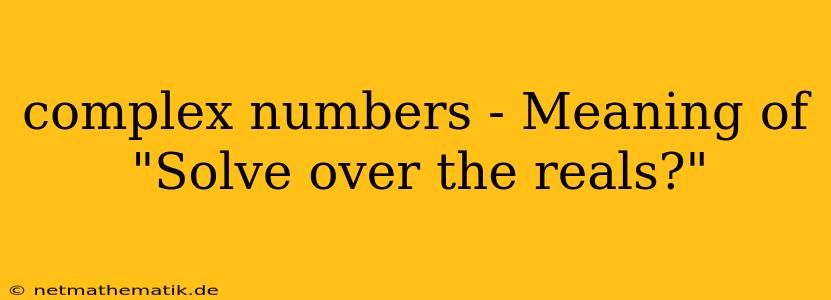The realm of mathematics is vast and intricate, encompassing various number systems that extend our understanding of quantities. Among these systems, complex numbers stand out for their unique properties and applications. Often encountered in advanced mathematics, complex numbers can be perplexing for those unfamiliar with their nature. One common question that arises is: "What does it mean to solve an equation over the reals?" This article aims to demystify this concept and provide a clear understanding of the significance of solving equations over the reals, particularly in the context of complex numbers.
The Essence of Real Numbers
To comprehend the meaning of "solving over the reals," we must first grasp the concept of real numbers. Real numbers are the set of all rational and irrational numbers, including all positive and negative numbers, zero, and fractions. They are represented on the number line and can be visualized as continuous points along it.
Examples of real numbers:
- 5
- -3.14
- √2
- 1/2
The Realm of Complex Numbers
Complex numbers, denoted by the letter 'C', encompass the set of real numbers and an additional imaginary unit, represented by the symbol 'i'. 'i' is defined as the square root of -1 (i² = -1). A complex number generally takes the form a + bi, where 'a' and 'b' are real numbers, and 'i' is the imaginary unit.
Examples of complex numbers:
- 3 + 2i
- -4 - i
- 7i
Solving Equations Over the Reals: A Focus on Real Number Solutions
When we are asked to "solve an equation over the reals," it essentially means we are looking for solutions that belong to the set of real numbers. We are searching for values of the unknown variable(s) that satisfy the equation and can be represented on the number line.
Example: The equation x² + 1 = 0 has no solutions in the set of real numbers. This is because there is no real number that, when squared, results in -1.
However, this equation does have solutions in the set of complex numbers. The solutions are x = i and x = -i.
Why Solve Over the Reals?
Solving equations over the reals is often a crucial step in various mathematical fields, such as:
- Algebra: Many algebraic equations and inequalities are solved over the reals to determine real-valued solutions.
- Calculus: Real numbers are fundamental to calculus, which deals with continuous functions and their derivatives, integrals, and limits.
- Physics and Engineering: Real numbers are used to represent physical quantities, such as distance, time, and mass, and their manipulation is essential in solving problems in these fields.
The Difference Between Solving Over the Reals and Solving in the Complex Domain
Solving over the reals focuses on finding real number solutions, while solving in the complex domain encompasses finding solutions that can be complex numbers.
Example: The quadratic equation x² - 2x + 2 = 0 has no real solutions. However, it does have two complex solutions: x = 1 + i and x = 1 - i.
Implications of Complex Solutions in Real-World Applications
While complex numbers might seem abstract, they have practical applications in diverse real-world scenarios. For instance, they are used in:
- Electrical Engineering: Complex numbers are employed to analyze alternating current (AC) circuits, where they represent impedance and phase shifts.
- Signal Processing: Complex numbers are crucial in digital signal processing, particularly in Fourier analysis, which transforms signals from the time domain to the frequency domain.
- Quantum Mechanics: Complex numbers play a fundamental role in quantum mechanics, where wave functions are described using complex numbers.
Summary
In conclusion, understanding the distinction between "solving over the reals" and solving in the complex domain is essential for comprehending the nuances of mathematical equations and their applications. Solving over the reals focuses on finding solutions within the set of real numbers, while solving in the complex domain encompasses the entire spectrum of complex numbers. While real numbers form the basis of many mathematical and real-world applications, complex numbers expand our mathematical toolkit and offer solutions to problems that might not be solvable within the confines of real numbers alone.
